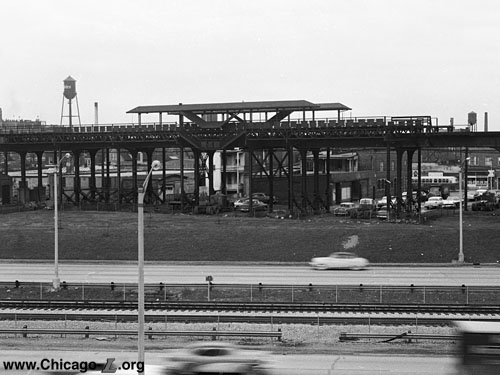|

The former Kilbourn is seen looking north across the Congress Expressway on March 16, 1958. The station had been closed for four-and-a-half years at the time of the photo, with the station house and lower section of platform stairs already removed; the platforms and canopies would be demolished a few years later. The Garfield Park elevated tracks the station is on were still in service at the time of the photo, though they would be closed too three months later, replaced by the new Congress Line in the expressway median in the foreground. For a larger view, click here. (CTA photo)
|
Kilbourn
(4500W/600S)
Kilbourn Avenue and
Harrison Street, West Garfield Park
Service
Notes:

|
Garfield
Line
|
Quick Facts:
Address: 616 S. Kilbourn Avenue
Established: June 19, 1895
Original Line: Metropolitan West Side Elevated, Garfield
Park branch
Previous Names: 45th Avenue, Kral
|
Skip-Stop
Type:
|

|
Station
|
Rebuilt: n/a
Status: Demolished
History:
The 45th Avenue station was opened in 1895 as part of the initial
stretch of the Met's Garfield
Park branch.
45th Avenue station -- later changed to Kilbourn Avenue --
consisted of a station house at street level and dual side platforms
at track level. The station house was originally probably typical of
the Met designs on the Northwest
and Garfield Park
branches. Constructed of red pressed brick with stone sills and
foundations, their vernacular style might best be described as Queen
Anne-influenced with some Romanesque features. The stations' original
design was highlighted by a semicircular bay/portico, a lattice
pattern in the brick cornice, extensive terra cotta work including
the word "entrance" above one door in the portico and "exit" above
the other, dentals above the doors' story lights, and carved wooden
beads flush with the building between the wooden brackets which
support a wooden canopy over the portico.
The station's dual side platforms had canopies and railings
typical of all Met stations: Designed into the railings were larger
cast iron square plates with a stylized diamond design. The stairs
and platforms were constructed of wood on a steel structure. Each
platform had a short canopy in the center of the platform, covering
the stairs and a small waiting area. The canopy frame was iron, with
arched latticed supports and bracketed rafters, and hipped roofs of
corrugated tin.
In the mid-1950s, work was undertaken to replace the Garfield
Line with a new rapid transit line in the median of the Congress
Expressway, parallel to and roughly a block from the Garfield
Line. Kilbourn closed on September 20, 1953 when the Garfield
Line was rerouted via temporary grade-level trackage along Van
Buren between Sacramento and Aberdeen due to expressway construction.
Kilbourn was not in the way of the construction project but was
closed due to its low patronage to speed up service on the Garfield
Line.
No replacement station was opened on the Congress
Line close to Kilbourn in 1958, but the Kostner
station was later added one block east of Kilbourn in 1962.
By March 1958, the station house and lower section of the stairs to the platforms had been removed. In August 1959, the Chicago Transit Board awarded a $106,646 contract to Lipsett Steel Products, Inc. to demolish the remaining stairs, platforms, canopies, railings, flooring, cross girders, columns, brackets and stringers at Kilbourn and five other closed Garfield
Park stations, as well as the elevated structure between Sacramento Blvd. and Lavergne Avenue.



